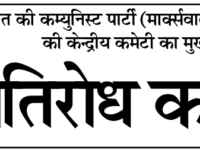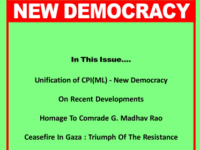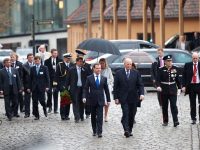‘Sau saal da ho gaya saka, ajee vi jaari samraji daka’
[Its been a hundred years since the incident (Jalianwala Bagh massacre), but the imperialist loot still goes on]
‘Amar shaheedan di soch te, pehra deyaange thok ke’
(We shall zealously guard the ideals and values of our martyrs)
‘Hakkaan lei jede ladhde log, jailaan to nahin darde log’
(People who fight for their rights do not fear the oppressor’s prisons)
These slogans, and many more, rendered the air thick with excitement and tumult in the quietude of Amritsar’s historic Company Bagh. They came from the villages, small towns and cities from all over Punjab to reclaim their revolutionary heritage on the occasion of 100th anniversary of the dastardly massacre of Jalianwala Bagh that happened on 13th April, 1919. Between five to six thousand students and youth belonging to PSU (Punjab Students Union) and NBS (Naujawan Bharat Sabha), along with some members of other fraternal organizations, converged on Amritsar to throw a challenge to the anti-people policies of the country’s rulers.
This congregation came at the end of a two-month long campaign undertaken by PSU and NBS to reach out to the people in every nook and corner of the state, to remind them of the rich revolutionary legacy of the toiling masses of India which tied them together, across the divisions of caste and religion, in their fight against both the foreign rulers and their Indian compradors. Much against the ritualistic sophistry of the ruling class politicians, that is on display on such occasions, these students and youth declared the pressing need to draw upon our revolutionary heritage to free the wretched of the Indian earth from the sub-human existence that they have endured thus far.
Just how little seems to have changed in last 100 years in the attitude of the rulers then and the rulers now, was once again demonstrated by the government of Punjab which imposed section 144 (banning the assembly of four or more persons) around Jalianwala Bagh, seemingly because a bevy of high profile ‘deshbhakts’ were scheduled to line up to pay their homage on the occasion; and so the people were required to be kept out. Thanks to the vigorous mobilizations and protest by the progressive sections of Punjab’s society, the government had to beat a retreat.
Before I leave you with the following photographs of the program, talking of section 144, I would like to briefly narrate an interesting incident. Queen Elizabeth had last visited India in 1997, during the reign of the ‘National Front’ government supported by the Left, with I K Gujral as the Prime Minister. Somehow, the queen and her husband, Prince Philip became insistent upon visiting Jalianwala Bagh to pay their homage to the victims. A demand arose from various sections of the society in India – what homage; the queen should apologise instead. The government of India, the faithful member of the ‘British Commonwealth’, however maintained an equanimous silence. Of course, the British government rejected the demand.
The demand then arose that the Indian government must not allow the queen to visit Jalianwala Bagh. But our minions wouldn’t budge; and so, it was decided to stage a real protest, right in front of the queen.
It was some day in the October of 1997, when the queen was to inaugurate an exhibition of treasures from the British Museum at the capital’s National Museum, around 11 am. There were around 20 to 25 of us, dressed to look as municipal workers, who went and sat under the trees in the patch of India Gate lawns right across the road in front of the National Museum, which had been turned into a parking lot. The paramilitary policemen shared the space with us. The leader of our motley group, Dr Mrigank, a biophysicist turned professional revolutionary, lurked innocuously behind a tree closer to the road. Just as the queen’s limousine arrived at the anointed time, Mrigank lurched towards it, pulling out a black flag from his pocket and shouting the slogan – ‘hatyari rani wapas ja’; ‘goron ki rani wapas ja.’ We all followed close on his heels. The police were simply befuddled. It actually became a security scandal. Paradoxically, BBC was the only channel to run the footage of the protest the whole day.
We spent two days in the lock-up, while the government decided on what to do with us. Finally, a case was lodged against us, which went on for 6 years in the Patiala House court. Among the sections slapped on us, was section 144; used first in 1861, this section was widely used by the British to ban nationalist assemblies in British India. Interestingly, it remains in force both in India and Pakistan, post 1947.
Our successful protest in Delhi, cost our comrades in Punjab dear. Similar attempt by them in Amritsar invited severe brutality on part of the police.
Meanwhile, the magistrate presiding over the case was a much-troubled soul. He wanted us to apologise, to set us free. We on our part assured him to hold such protest under similar circumstances, were they to arise again. He could neither convict us (for obvious political fallout), nor could he let us go just like that. Finally, another magistrate disposed off the case, 6 years later, by levying a fine of Rs 50 against each one of us.
The point pertinent to our present circumstances is, that in this election season, we are being told to choose between ‘Hindutva’ and ‘Soft-Hindutva’ (which is the de facto case). This hardly is any choice. These youth who congregated at Amritsar, had their own set of alternatives. The question is – are we willing to bite their challenge? The choice is entirely yours.
I had to catch the evening Shatabdi back to Delhi, and so could not join the rally taken out from Company Bagh to the Jalianwala Bagh that evening. But the comrades informed that it received an enthusiastic reception from the common people.
-Vikas Bajpai


